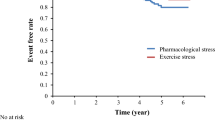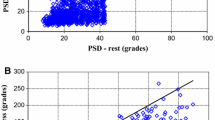Abstract
Background
Cardiac resynchronization therapy (CRT) reduces morbidity and mortality in chronic systolic heart failure. About 20% of implanted patients are considered as “non-responders”. This study aimed to evaluate gated myocardial perfusion single-photon emission computed tomography (GMPS) phase parameters as compared to echocardiography in the assessment of predictors for response to CRT before and after CRT activation.
Methods
Forty-two patients were prospectively included during 15 months. A single injection of 99mTc-tetrofosmin was used to acquire GMPS phase pre- and post-CRT activation. Indicators of positive CRT response were improvement of functional status and 15% reduction in left ventricular end-systolic volume at 3 months.
Results
Phase parameters at baseline were similar in the two groups with no influence of perfusion data. Phase parameters after CRT activation were significantly improved in the responders’ group (Δ Bandwidth −19° ± 24° vs. 13° ± 31°, p = 0.001; Δ SD −20° ± 30° vs. 26° ± 46°, p = 0.001; Δ Entropy −11 ± 12 vs. 2 ± 6%, p = 0.001). Feasibility and reproducibility were higher for GMPS.
Conclusion
Acute phase modifications after CRT activation may predict response to CRT immediately after implantation, but not at baseline, even when adjusted to perfusion data.

Similar content being viewed by others
Abbreviations
- β:
-
Bandwidth
- Ә:
-
Entropy
- ε :
-
Strain
- CRT:
-
Cardiac resynchronization therapy
- GMPS:
-
Gated myocardial perfusion SPECT
- HF:
-
Heart failure
- ICC:
-
Intraclass correlation
- ICM:
-
Ischemic cardiomyopathy
- IVMD:
-
Interventricular mechanical delay
- LLWC:
-
Left lateral wall contraction
- LV:
-
Left ventricle
- LVEF:
-
Left ventricular ejection fraction
- LVEDV:
-
Left ventricular end-diastolic volume
- LVESV:
-
Left ventricular end-systolic volume
- LVFT:
-
Left ventricular filling time
- LWMP:
-
Lateral wall myocardial perfusion
- NYHA:
-
New York Heart Association
- TTE:
-
Trans-thoracic echocardiography
- SD:
-
Standard deviation
- SPECT:
-
Single-photon emission computed tomography
- SPWMD:
-
Septal-posterior wall motion delay
References
Abraham WT, Fisher W, Smith A, Delurgio DB, Leon A, Loh E, et al. Cardiac resynchronization in chronic heart failure. N Engl J Med. 2002;346:1845–53.
Auricchio A, Stellbrink C, Sack S, Block M, Vogt J, Bakker P, et al. Long-term clinical effect of hemodynamically optimized cardiac resynchronization therapy in patients with heart failure and ventricular conduction delay. J Am Coll Cardiol. 2002;39(12):2026–33.
Cleland JGF, Daubert JC, Erdmann E, Freemantle N, Gras D, Kappenberger L, et al. The effect of cardiac resynchronization on morbidity and mortality in heart failure. N Engl J Med. 2005;352:1539–49.
Brignole M, Auricchio A, Baron-Esquivias G, et al. 2013 ESC Guidelines on cardiac pacing and cardiac resynchronization therapy. Eur Heart J. 2013;34:2281–329.
Auricchio A, Prinzen FW. Non-responders to cardiac resynchronization therapy—the magnitude of the problem and the issues. Circ J. 2011;75:521–7.
Yu CM, Sanderson JE, Gorcsan J III. Echocardiography, dyssynchrony, and the response to cardiac resynchronization therapy. Eur Heart J. 2010:2326–37.
Yu CM, Zhang Q, Fung JW, Chan HC, Chan YS, Yip GW, et al. A novel tool to assess systolic asynchrony and identify responders of cardiac resynchronization therapy by tissue synchronization imaging. J Am Coll Cardiol. 2005;45:677–84.
Lim P BA, Popovi ZB, Greenberg NL, Patel D, Thomas JD, et al. Longitudinal strain delay index by speckle tracking imaging: a new marker of response to cardiac resynchronization therapy. Circulation. 2008;118:1130–7.
Seo Y, Ito H, Nakatani S, Takami M, Naito S, Shiga T, et al. The role of echocardiography in predicting responders to cardiac resynchronization therapy—results from the Japan Cardiac Resynchronization Therapy Registry Trial (J-CRT). Circ J. 2011;75:1156–63.
Chung ES, Leon AR, Tavazzi L, Sun JP, Nihoyannopoulos P, Merlino J, et al. Results of the predictors of response to CRT (PROSPECT) Trial. Circulation. 2008;117(20):2608–16.
Ruschitzka F, Abraham WT, Singh JP, Bax JJ, Borer JS, Brugada J, et al. Cardiac-resynchronization therapy in heart failure with a narrow QRS complex. N Engl J Med. 2013;369(10):1395–405.
Doltra A, Bijnens B, Tolosana JM, Borràs R, Khatib M, Penela D, et al. Mechanical abnormalities detected with conventional echocardiography are associated with response and midterm survival in CRT. JACC Cardiovasc Imaging. 2014;7(10):969–79.
Henneman MM, Chen J, Dibbets-Schneider P, Stokkel MP, Bleeker GB, Ypenburg C, et al. Can LV dyssynchrony as assessed with phase analysis on gated myocardial perfusion SPECT predict response to CRT? J Nucl Med. 2007;48:1104–11.
Henneman MM, Chen J, Ypenburg C, Dibbets P, Bleeker GB, Boersma E, et al. Phase analysis of gated myocardial perfusion single-photon emission computed tomography compared with tissue Doppler imaging for the assessment of left ventricular dyssynchrony. J Am Coll Cardiol. 2007;49.
Boogers MJ, Chen J, Veltman CE, van Bommel R J, Mooyaart EAQ, Al Younis I, et al. Left ventricular diastolic dyssynchrony assessed with phase analysis of gated myocardial perfusion SPECT: a comparison with tissue Doppler imaging. Eur J Nucl Med Mol Imaging. 2011;38:2031–9.
Van Kriekinge SD, Nishina H, Ohba M, Berman DS, Germano G. Automatic global and regional phase analysis from gated myocardial perfusion SPECT Imaging: application to the characterization of ventricular contraction in patients with left bundle branch block. J Nucl Med. 2008;49.
Boogers MM, Van Kriekinge SD, Henneman MM, Ypenburg C, Van Bommel RJ, Boersma E, et al. Quantitative gated SPECT derived phase analysis on gated myocardial perfusion SPECT detects left ventricular dyssynchrony and predicts response to cardiac resynchronization therapy. J Nucl Med. 2009;50:718–25.
Shannon CE. A mathematical theory of communication. Bell Syst Tech J. 1948;27:623–56.
Gasparini M, Regoli F, Ceriotti C, Galimberti P, Bragato R, De Vita S, et al. Remission of left ventricular systolic dysfunction and of heart failure symptoms after cardiac resynchronization therapy: temporal pattern and clinical predictors. Am Heart J. 2008;155:507–14.
Adelstein EC, Tanaka H, Soman P, Miske G, Haberman SC, Saba SF, et al. Impact of scar burden by single-photon emission computed tomography myocardial perfusion imaging on patient outcomes following cardiac resynchronization therapy. Eur Heart J. 2011(32):93–103.
Ypenburg C, Van Bommel R J, Willem Borleffs CJ, Bleeker GB, Boersma E, Schalij MJ, et al. Long-term prognosis after cardiac resynchronization therapy is related to the extent of left ventricular reverse remodeling at midterm follow-up. J Am Coll Cardiol. 2009;53(6):483–90.
Azizian N RF, Ghaedian T, Golabchi A, Bahadorian B, Khanlarzadeh V, et al. LV dyssynchrony assessed with phase analysis on gated myocardial perfusion SPECT can predict response to CRT in patients with end-stage heart failure. Res Cardiovasc Med. 2014;3(4):e20720.
Friehling M, Chen J, Saba S, Bazaz R, Schwartzman D, Adelstein EC, et al. A prospective pilot study to evaluate the relationship between acute change in left ventricular synchrony after cardiac resynchronization therapy and patient outcome using a single-injection gated SPECT protocol. Circ Cardiovasc Imaging. 2011;4:532–9.
Higgins SL, Hummel JD, Niazi IK, Giudici MC, Worley SJ, Saxon LA, et al. Cardiac resynchronization therapy for the treatment of heart failure in patients with intraventricular conduction delay and malignant ventricular tachyarrhythmias. J Am Coll Cardiol. 2003;42(8):1454–9.
Author information
Authors and Affiliations
Corresponding author
Ethics declarations
Conflict of interest
The authors declare no conflict of interest or disclosure statement.
Rights and permissions
About this article
Cite this article
Gendre, R., Lairez, O., Mondoly, P. et al. Research of predictive factors for cardiac resynchronization therapy: a prospective study comparing data from phase-analysis of gated myocardial perfusion single-photon computed tomography and echocardiography. Ann Nucl Med 31, 218–226 (2017). https://doi.org/10.1007/s12149-017-1148-5
Received:
Accepted:
Published:
Issue Date:
DOI: https://doi.org/10.1007/s12149-017-1148-5




